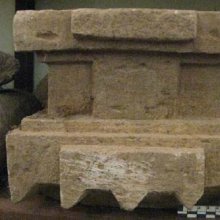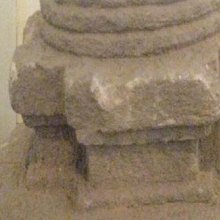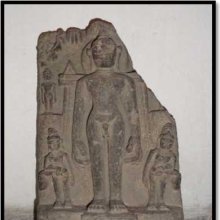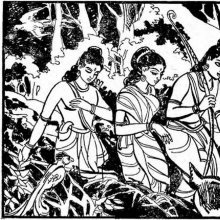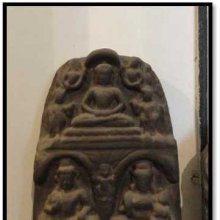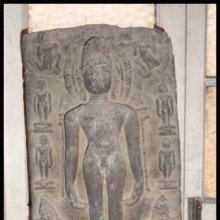Atri, Attri, Attṛ, Ātṝ: 29 definitions
Introduction:
Atri means something in Hinduism, Sanskrit, the history of ancient India, Marathi. If you want to know the exact meaning, history, etymology or English translation of this term then check out the descriptions on this page. Add your comment or reference to a book if you want to contribute to this summary article.
The Sanskrit terms Attṛ and Ātṝ can be transliterated into English as Attr or Attri or Atr or Atri, using the IAST transliteration scheme (?).
Images (photo gallery)
In Hinduism
Purana and Itihasa (epic history)
Source: Wisdom Library: Bhagavata PuranaAtri (अत्रि):—Son of Brahmā. From Atri’s tears was born a son named Soma, the moon. His wife was called Anasūyā. She was impregnated by the tears of Atri, and had three sons called Soma, Durvāsā and Dattātreya. (see Bhāgavata Purāṇa 9.14.2-3)
Source: archive.org: Puranic Encyclopedia1) Atri (अत्रि).—The son of Brahmā. Atri Maharṣi was one of the mānasaputras of Brahmā. The mānasaputras were: Marīci, Aṅgiras, Atri, Pulastya, Pulaha, and Kratu (Mahābhārata, Ādi Parva, Chapter 65, Verse 10). (See full article at Story of Atri from the Puranic encyclopaedia by Vettam Mani)
2) Atri (अत्रि).—In the Purāṇas another Atri, the son of Śukrācārya, is also seen (Mahābhārata, Ādi Parva, Chapter 65, Verse 27).
3) Atri (अत्रि).—The term Atri has been used as an epithet of Śiva. (Mahābhārata, Anuśāsana Parva, Chapter 17, Verse 38).
Source: archive.org: Shiva Purana - English Translation1) Atri (अत्रि) was created as a Sādhaka (aspirant) by Brahmā out of his ears (śrotra), according to the Śivapurāṇa 2.1.16:—“[...] I [viz., Brahmā] created many other things as well, but O sage, I was not satisfied. Then O sage, I meditated on Śiva and his consort Ambā and created aspirants (sādhakas). [...] I created Atri from the ears (śrotra), [...] O foremost among sages, creating thus, thanks to the favour of Mahādeva, these excellent Sādhakas (e.g., Atri) I became contented. Then, O dear one, Dharma, born out of my conception assumed the form of Manu at my bidding and was engaged in activity by the aspirants”.
2) Atri (अत्रि) is the name of a Sage (Muni) who once attended a great sacrifice by Dakṣa, according to the Śivapurāṇa 2.2.27. Accordingly as Brahmā narrated to Nārada:—“[...] once a great sacrifice was started by Dakṣa, O sage. To partake in that sacrifice, the celestial and terrestrial sages and devas were invited by Śiva and they reached the place being deluded by Śiva’s Māyā. [Atri, ...] and many others along with their sons and wives arrived at the sacrifice of Dakṣa—my son”.
Source: Cologne Digital Sanskrit Dictionaries: The Purana Index1a) Atri (अत्रि).—A son of Brahmā, born of his eyes.1 Father of Soma, born of his eyes.2 Married Anasūyā, a daughter of Kardama (Dakṣa). Their son was Dattātreya (s.v.). Taught ānvīkṣikī to Alarka, Praḥlāda and others.3 Paid a visit to Bhīṣma who was in his death-bed.4 Came to see Parīkṣit practising prāyopaveśa.5 A sage.6 Was engaged with his wife in meditation at Mount Ṛkṣa by prāṇāyāma for the birth of a son. His praise of Trimūrtis who appeared before him, and blessed him with three glorious sons, being their own aṃśas. Accordingly Datta (Viṣṇu), Durvāsas (Śiva), and Soma (Brahmā) were born.7 Pointed out to Pṛthu's son, Indra running away with the consecrated horse twice and urged him to slay him.8 Had not yet seen the Supreme Being.9 A sage of the Vaivasvata epoch.10 Went with Kṛṣṇa to Mithilā.11 The sage who presides over the month of Śukra12 and Śuci.13 A mantrakāra took Uttānapāda as his son.14 Had a daughter, a Brahmavādinī. Visited Paraśurāma engaged in austerities.15 Worshipped Pitṛs by śrāddha and relieved Soma of the disease rājayakṣma.16 Appointed by Brahmā for creation of the world he performed the tapas called anuttama when Śiva saw him: acted as hotā for Soma's rājasūya16 Hermitage in the Himalayas, visited by Purūravas:17 Praised Śiva out to destroy Tripuram.18
- 1) Bhāgavata-purāṇa III. 12. 22 & 24; Matsya-purāṇa 3. 6; 9. 27.
- 2) Bhāgavata-purāṇa IX. 14. 2-3; Brahmāṇḍa-purāṇa III. 65. 1 & 47; Vāyu-purāṇa 1. 138; 3. 3; 30. 48.
- 3) Bhāgavata-purāṇa I. 3. 11; III. 24. 22. Brahmāṇḍa-purāṇa II. 9. 56.
- 4) Bhāgavata-purāṇa I. 9. 7.
- 5) Bhāgavata-purāṇa I. 19. 9.
- 6) Ib. II. 7. 4. Vāyu-purāṇa 90. 1-8.
- 7) Bhāgavata-purāṇa IV. 1. 15-33; Viṣṇu-purāṇa IV. 6. 5-6.
- 8) Bhāgavata-purāṇa IV. 19. 12-15 and 21.
- 9) Ib. IV. 29. 43.
- 10) Ib. VIII. 13. 5; Brahmāṇḍa-purāṇa II. 38. 25.
- 11) Bhāgavata-purāṇa X. 86. 18.
- 12) Ib. XII. 11. 35.
- 13) Brahmāṇḍa-purāṇa II. 23. 5. Vāyu-purāṇa 52. 6. Viṣṇu-purāṇa II. 10. 7; III. 1. 32.
- 14) Brahmāṇḍa-purāṇa II. 27. 104; 32. 96 & 113.
- 15) Brahmāṇḍa-purāṇa III. 23. 4.
- 16) Brahmāṇḍa-purāṇa III. 10. 111; Vāyu-purāṇa 73. 63;
- 17) Matsya-purāṇa 102. 19; 118. 62 & 77; 120. 45; 126. 7.
- 18) Matsya-purāṇa 133. 67.
1b) One of the sages who left for Piṇḍāraka.*
- * Bhāgavata-purāṇa XI. 1. 12.
1c) The third Prajāpati Of Svāyambhuva epoch, created by Brahmā from ahaṃ tṛtīya.*
- * Brahmāṇḍa-purāṇa I. 1. 117; 5. 70; II. 9. 18, 23; Vāyu-purāṇa 31. 16; 34. 62; 65. 45; Viṣṇu-purāṇa V. 1. 17.
1d) (c)—a northern kingdom.*
- * Brahmāṇḍa-purāṇa II. 16. 50.
1e) Born in vāruṇī yajña from Agni's flames;1 Had ten beautiful and chaste wives, all daughters of Bhadrāśva and Ghṛtācī. His ten sons were all known as Ātreyas,2 also Svastyātreyas; a mahaṛṣi and a mantrakṛt. Tra yārṣeya with Vasiṣṭha and Jātūkarṇa: a contemporary of Vṛddha Garga.3 One of the 18 writers on architecture. Has a place in the viśvacakra.4
- 1) Brahmāṇḍa-purāṇa III. 1. 21 & 44; 8. 73; Matsya-purāṇa 171. 27; 192. 10; 195. 9; Vāyu-purāṇa 62. 17; 64. 27; Viṣṇu-purāṇa I. 7. 5, 7.
- 2) Vāyu-purāṇa 70. 67-76.
- 3) Matsya-purāṇa 145. 90, 107-9; 197. 1 & 4; 200. 19; 229. 2 & 3; Vāyu-purāṇa 59. 104.
- 4) Matsya-purāṇa 252. 2; 285-6.
1f) The avatār of the Lord in the 12th dvāpara in the Haimaka forest with sons with bath and ashes.*
- * Vāyu-purāṇa 23. 155.
1g) A son of Gautama, an avatār of the Lord.*
- * Vāyu-purāṇa 23. 164.
Atri (अत्रि) is mentioned as one of the seven mind-born sons of Brahmā, also known as the seven prajāpatis, or the seven brahmās, according to the first chapter of the Brahma-purāṇa (on the origin of Devas and Asuras). Accordingly, “Desirous of evolving creation befitting these, he created Prajāpatis (Lords of subjects) viz. Marīci, Atri, Aṅgiras, Pulastya, Pulaha, Kratu and Vasiṣṭha. Thus the lord of great refulgence created seven mental sons. In the Purāṇas these are known as the seven Brahmās”.
Atri is also mentioned as the father of Soma in the seventh chapter of the Brahma-purāṇa (birth of Soma). Accordingly, “O Brahmins, the father of Soma, the saintly lord Atri was the mind-born son of Brahmā who was desirous of creating subjects. Formerly, Atri performed a great penance for three thousand divine years. So we have heard. His semen attaining the state of Soma juice rose up. Water exuded from his eyes in ten directions and illuminated the ten quarters.”.
The Brahmapurāṇa (mentioning Atri) is one the eighteen mahāpurāṇas originally composed of over 10,000 verses. The first three books of the extant edition contains a diverse amount of topics such as creation theory, cosmology, mythology, philosophy and genealogy. The fourth and last part represents pilgrimage’s travel guide (māhātmya) and narrates the legends surrounding numerous holy spots (tīrtha) around the Godāvarī region in India.
Source: JatLand: List of Mahabharata people and placesAtri (अत्रि) is a name mentioned in the Mahābhārata (cf. I.59.10, I.65, I.59.36, I.65, I.60.4) and represents one of the many proper names used for people and places. Note: The Mahābhārata (mentioning Atri) is a Sanskrit epic poem consisting of 100,000 ślokas (metrical verses) and is over 2000 years old.
Source: Shodhganga: The saurapurana - a critical study1) Atri (अत्रि) married Anasuyā: one of the daughters of Dakṣa and Prasūti: one of the two daughters of Manu-svāyaṃbhuva and Śatarūpā, according to the Vaṃśa (‘genealogical description’) of the 10th century Saurapurāṇa: one of the various Upapurāṇas depicting Śaivism.—Accordingly, Ākūti was married to Ruci and Prasūti to Dakṣa. Dakṣa produced in Prasūti twenty-four daughters. [...] [ Anasuyā was given to Atri.]. [...] Atri and Anasuyā gave birth to Durvāsas, Soma (or Candramas) and Dattātreya.
2) Atri (अत्रि) is the name of one of the seven sages (saptarṣi) in the Cākṣuṣamanvantara: one of the fourteen Manvantaras.—Accordingly, “In cākṣuṣamanvantara, Manojava was the Indra, Bhāva and others who were the progeny of Āyu were said to be the deities. The seven sages were Sudhāmā, Virajā, Haviṣmān, Uttama, Budha, Atri and Sahiṣṇu”.
3) Atri (अत्रि) also refers to one of the seven sages (saptarṣi) in the Vaivasvatamanvantara.—Accordingly, “The present, the seventh manvantara is Vaivasvata [viz., vaivasvatamanvantara]. In this manvantara, Purandara is the Indra who is the Subduer of the pride of the Asuras; The gods are the Ādityas, the Rudras, the Vasus and the Maruts. The seven seers are Vasiṣṭha, Kaśyapa, Atri, Jamadagni, Gautama, Viśvāmitra and Bharadvāja”.

The Purana (पुराण, purāṇas) refers to Sanskrit literature preserving ancient India’s vast cultural history, including historical legends, religious ceremonies, various arts and sciences. The eighteen mahapuranas total over 400,000 shlokas (metrical couplets) and date to at least several centuries BCE.
Shaktism (Shakta philosophy)
Source: Wisdom Library: Śrīmad Devī BhāgavatamAtri (अत्रि):—One of the mind-born sons of Brahmā, according to the Devī-bhāgavata-purāṇa (chapter on the Devī-yajña). They were created by the sheer power of mind.

Shakta (शाक्त, śākta) or Shaktism (śāktism) represents a tradition of Hinduism where the Goddess (Devi) is revered and worshipped. Shakta literature includes a range of scriptures, including various Agamas and Tantras, although its roots may be traced back to the Vedas.
Vaishnavism (Vaishava dharma)
Source: Pure Bhakti: Brhad BhagavatamrtamAtri (अत्रि) refers to:—One of the ten sages born of Brahmā. (cf. Glossary page from Śrī Bṛhad-bhāgavatāmṛta).

Vaishnava (वैष्णव, vaiṣṇava) or vaishnavism (vaiṣṇavism) represents a tradition of Hinduism worshipping Vishnu as the supreme Lord. Similar to the Shaktism and Shaivism traditions, Vaishnavism also developed as an individual movement, famous for its exposition of the dashavatara (‘ten avatars of Vishnu’).
Vastushastra (architecture)
Source: archive.org: Bharatiya vastu-sastraAtri (अत्रि) is the name of an ancient teacher (ācārya) of Vāstuśāsta (science of architecture) according to the Matsyapurāṇa.—All these great teachers cannot be said to be legendary. Some used to be propagated in ancient India. No nation can flourish without its care for its material prosperity. All this technique and training and their systematic and successful teaching and transmission were of equal importance. Most of the treatises of Vāstuśāstra carry many of these names [i.e., Atri], yet a good many of them are quoted as authorities, yet still others are honoured with actual passages being quoted from their works.

Vastushastra (वास्तुशास्त्र, vāstuśāstra) refers to the ancient Indian science (shastra) of architecture (vastu), dealing with topics such architecture, sculpture, town-building, fort building and various other constructions. Vastu also deals with the philosophy of the architectural relation with the cosmic universe.
Jyotisha (astronomy and astrology)
Source: Wisdom Library: Brihat Samhita by Varahamihira1) Atri (अत्रि) refers to one of the Seven Ṛṣis (saptarṣi), according to the Bṛhatsaṃhitā (chapter 13), an encyclopedic Sanskrit work written by Varāhamihira mainly focusing on the science of ancient Indian astronomy astronomy (Jyotiṣa).—Accordingly, “During the reign of Yudhisthira, 2526 years before the commencement of Vikrama Śaka, the Seven Ṛṣis (saptarṣi) were at the constellation of Maghā (Regulus). The Ṛṣis take a period of 100 years to go over each of the 27 asterisms. They rise in the north-east and are accompanied by the chaste Arundhatī—the consort of Vasiṣṭha. The eastern-most of the group is Bhagavān Marīci; the next to him is Vasiṣṭha; the next is Aṅgiras and the next two are—Atri and Pulastya. The next in order are the Ṛṣis—Pulaha and Kratu. The chaste Arundhatī closely attends her husband the sage Vasiṣṭha”.
2) Atri (अत्रि) [=Trivāricara?] or Atridvīpa refers to an island belonging to “Dakṣiṇa or Dakṣiṇadeśa (southern division)” classified under the constellations of Uttaraphālguni, Hasta and Citrā, according to the system of Kūrmavibhāga, according to the Bṛhatsaṃhitā (chapter 14).—Accordingly, “The countries of the Earth beginning from the centre of Bhāratavarṣa and going round the east, south-east, south, etc., are divided into 9 divisions corresponding to the 27 lunar asterisms at the rate of 3 for each division and beginning from Kṛttikā. The constellations of Uttaraphālguni, Hasta and Citrā represent the southern division consisting of [i.e., Atri-dvīpa] [...]”.

Jyotisha (ज्योतिष, jyotiṣa or jyotish) refers to ‘astronomy’ or “Vedic astrology” and represents the fifth of the six Vedangas (additional sciences to be studied along with the Vedas). Jyotisha concerns itself with the study and prediction of the movements of celestial bodies, in order to calculate the auspicious time for rituals and ceremonies.
Ganitashastra (Mathematics and Algebra)
Source: archive.org: Hindu MathematicsAtri (अत्रि) represents the number 7 (seven) in the “word-numeral system” (bhūtasaṃkhyā), which was used in Sanskrit texts dealing with astronomy, mathematics, metrics, as well as in the dates of inscriptions and manuscripts in ancient Indian literature.—A system of expressing numbers by means of words arranged as in the place-value notation was developed and perfected in India in the early centuries of the Christian era. In this system the numerals [e.g., 7—atri] are expressed by names of things, beings or concepts, which, naturally or in accordance with the teaching of the Śāstras, connote numbers.

Ganitashastra (शिल्पशास्त्र, gaṇitaśāstra) refers to the ancient Indian science of mathematics, algebra, number theory, arithmetic, etc. Closely allied with astronomy, both were commonly taught and studied in universities, even since the 1st millennium BCE. Ganita-shastra also includes ritualistic math-books such as the Shulba-sutras.
General definition (in Hinduism)
Source: Apam Napat: Indian MythologyAtri is one of the seven sages, the SaptaRishis. He is better known as the husband of the chastest of all women, Anasuya. According to the Maarkandeya Purana, he is the father of Chandra.
Source: WikiPedia: HinduismIn Hinduism, Atri (Sanskrit: अत्रि) or Attri is a legendary bard and scholar and was one of 9 Prajapatis, and a son of Brahma, said to be ancestor of some Brahmin, Prajapatis, kshatriya and Vaishya communities who adopt Atri as their gotra. Atri is the Saptarishis (Seven Great Sages Rishi) in the seventh, i.e. the present Manvantara. Brahmarshi Atri is the seer in the fifth Mandala (chapter) of the Rigveda.
Source: Sri Kamakoti Mandali: HinduismThe Vimānārcakakalpa (of marīci) names four works of atri, composed of eighty-eight thousand verses in anuṣṭup meter:
- pūrvatantra,
- ātreyatantra,
- viṣṇutantra,
- uttaratantra.
The Ānanda saṃhitā lists four works of atri:
- pūrvatantra,
- viṣṇutantra,
- uttaratantra,
- mahātantra.
The Samūrtārcanādhikaraṇa (of atri), four works are attributed to atri:
- pādyatantra,
- uttaratantra,
- viṣṇutantra,
- ātreyatantra.
India history and geography
Source: Cologne Digital Sanskrit Dictionaries: Indian Epigraphical GlossaryAtri.—(IE 7-1-2), ‘seven’. Note: atri is defined in the “Indian epigraphical glossary” as it can be found on ancient inscriptions commonly written in Sanskrit, Prakrit or Dravidian languages.

The history of India traces the identification of countries, villages, towns and other regions of India, as well as mythology, zoology, royal dynasties, rulers, tribes, local festivities and traditions and regional languages. Ancient India enjoyed religious freedom and encourages the path of Dharma, a concept common to Buddhism, Hinduism, and Jainism.
Languages of India and abroad
Marathi-English dictionary
Source: DDSA: The Molesworth Marathi and English Dictionaryatri (अत्रि).—m (S From the ṛṣi of this name.) A tribe of Brahmans or an individual of it.
Marathi is an Indo-European language having over 70 million native speakers people in (predominantly) Maharashtra India. Marathi, like many other Indo-Aryan languages, evolved from early forms of Prakrit, which itself is a subset of Sanskrit, one of the most ancient languages of the world.
Sanskrit dictionary
Source: DDSA: The practical Sanskrit-English dictionaryAttṛ (अत्तृ).—&c. See under अद् (ad).
--- OR ---
Atri (अत्रि).—a. [properly a, Uṇādi-sūtra 4.68, adestriniśca, ad-trin] Devourer; अत्रिमनु स्वराज्यमग्निभ् (atrimanu svarājyamagnibh) Ṛgveda 2.8.5.
-triḥ Name of a celebrated sage and author of many Vedic hymns. [He appears in the Vedas in hymns addressed to Agni, Indra, the Aśvins and the Viśvedevas. In the Svāyambhuva Manvantara, he appears as one of the ten Prajāpatis or mind-born sons of Brahmā, being born from his eye. These sons having died by the curse of Śiva, Brahmā performed a sacrifice, at the beginning of the present Vaivasvata Manvantara, and Atri was born from the flames of Agni. Anasūyā was his wife in both lives. In the first, she bore him three sons, Datta, Durvāsas and Soma; in the second, she had two additional children, a son by name Aryaman and a daughter called Amalā. In the Rāmāyaṇa an account is given of the visit paid by Rāma and Sītā to Atri and Anasūyā in their hermitage, when they both received them most kindly. (See Anasūyā.) As a Riṣi or sage he is one of the seven sages who were all sons of Brahmā, and represents in Astronomy one of the stars of the Great Bear situated in the north. He is also the author of a code of laws known as अत्रिस्मृति (atrismṛti) or अत्रिसंहिता (atrisaṃhitā). In the Purāṇas he is said to have produced the moon from his eye, while he was practising austere penance, the moon being in consequence called अत्रिज, -जात, -दृग्ज, अत्रिनेत्रप्रसूत, -°प्रभव, °भव (atrija, -jāta, -dṛgja, atrinetraprasūta, -°prabhava, °bhava) &c.; cf. also अथ नयनसमुत्थं ज्योतिरत्रेरिव द्यौः (atha nayanasamutthaṃ jyotiratreriva dyauḥ) R.2.75. and अत्रेरिवेन्दुः (atrerivenduḥ) V.5.21] (pl.) descendants of Atri.
-atrī wife of अत्रि (atri); अत्रिरञ्य नमस्कर्ता (atrirañya namaskartā) Mahābhārata (Bombay) 13.17.38.
--- OR ---
Attṛ (अत्तृ).—a. [ad-tṛc] One who eats; अरक्षितारमत्तारं नृपं विद्यादधोगतिम् (arakṣitāramattāraṃ nṛpaṃ vidyādadhogatim). Manusmṛti 8.39.
--- OR ---
Ātṝ (आतॄ).—1 P.
1) To pass through or over; उक्षन्ते अश्वान् तरुषन्त आ रजः (ukṣante aśvān taruṣanta ā rajaḥ) Ṛgveda 5.59.1.
2) To cross over.
3) To overcome.
4) To enlarge, increase.
Source: Cologne Digital Sanskrit Dictionaries: Edgerton Buddhist Hybrid Sanskrit DictionaryAtri (अत्रि).—see Ati.
Source: Cologne Digital Sanskrit Dictionaries: Shabda-Sagara Sanskrit-English DictionaryAttṛ (अत्तृ).—mfn. (-ttā-ttvī-ttṛ) A feeder, one who eats. E. ada to eat. śatṛ aff.
--- OR ---
Atri (अत्रि).—m.
(-triḥ) The name of one of one of the seven Rishis or saints, born from the eye of Rrahma, married to Anasuya, daughter of Kerdama Muni, and the father of Datta or Dattatreyi, Durvasas and Chandra. E. ada to eat and trip Unadi aff. The correct reading is attri, but the word is always written with one ta.
--- OR ---
Attri (अत्त्रि).—m.
(-ttriḥ) A sage. See attri.
Source: Cologne Digital Sanskrit Dictionaries: Benfey Sanskrit-English DictionaryAttṛ (अत्तृ).—i. e. ad + tṛ, m. One who eats, [Mānavadharmaśāstra] 5, 30; (a king) who swallows up the possessions of his people, [Mānavadharmaśāstra] 8, 309.
--- OR ---
Atri (अत्रि).—m. The name of a Ṛṣi, or saint, [Mānavadharmaśāstra] 1, 35.
Source: Cologne Digital Sanskrit Dictionaries: Cappeller Sanskrit-English DictionaryAttṛ (अत्तृ).—[masculine] eater, devourer; [feminine] attrī.
--- OR ---
Atri (अत्रि).—[adjective] eating, devouring. [masculine] [Name] of a Ṛṣi & star in the Great Bear, [plural] the descendants of Atri.
--- OR ---
Ātṛ (आतृ).—pass, cross, overcome; enlarge, increase.
Ātṛ is a Sanskrit compound consisting of the terms ā and tṛ (तृ).
Source: Cologne Digital Sanskrit Dictionaries: Monier-Williams Sanskrit-English Dictionary1) Attṛ (अत्तृ):—[from attavya] a m. an eater, [Atharva-veda] etc.; f(attrī). , [Taittirīya-saṃhitā]
2) Attri (अत्त्रि):—See atri, p. 17, col. 2.
3) Atri (अत्रि):—[from atra] m. (for at-tri, [from] √ad), a devourer, [Ṛg-veda ii, 8, 5]
4) [v.s. ...] Name of a great Ṛṣi, author of a number of Vedic hymns
5) [v.s. ...] (in [astronomy]) one of the seven stars of the Great Bear
6) [v.s. ...] [plural] (atrayas) the descendants of Atri.
7) Attṛ (अत्तृ):—[from ad] b etc. See sub voce
8) Ātṝ (आतॄ):—[=ā-√tṝ] [Parasmaipada] ([imperfect tense] ātirat, 2. sg. ras) to overcome, [Ṛg-veda];
— ([imperfect tense] ātirat, 2. sg. ras, 3. [plural] [Ātmanepada] ranta) to increase, make prosperous, glorify, [Ṛg-veda] :
—[Intensive] [Ātmanepada] (3. [plural] -taruṣante) to pass through or over, [Ṛg-veda v, 59, 1.]
Source: Cologne Digital Sanskrit Dictionaries: Goldstücker Sanskrit-English DictionaryAttṛ (अत्तृ):—m. f. n. (-ttā-ttrī-ttṛ) An eater, one who eats. See attrin. E. ad, kṛt aff. tṛc.
--- OR ---
Attri (अत्त्रि):—m.
(-ttriḥ) . See atri the less correct, but more usual reading of this word. E. ad, uṇ. aff. trip. See the following.
--- OR ---
Atri (अत्रि):—m.
(-triḥ) 1) Eater, devourer (in the Vedas especially as an epithet of Agni, the divinity of fire).
2) The name of a Maharshi or a great Saint, who in the Vedas occurs especially in hymns composed for the praise of Agni, Indra, the Aśviṃs and the Viśvadevas; and who in the epic period is considered as one of the ten Prajāpatis or lords of creation engendered by Manu for the purpose of creating the universe; at a later period he appears as a mindborn son of Brahmā and as one of the seven Ṛṣis who preside over the reign of Svāyambhuva, the first, or according to others of Svārochiṣa, the second, or of Vaivaswata, the seventh Manu; he is married to Anasūyā, the daughter of Daksha and their son is Durvāsas. Produced by a flash of light from his eye which was received by Space, the via lactea personified, or according to a more recent legend, by his penitence, is Soma or the moon. See atrijāta, atridṛgja, atrinetraja &c. As sons of his are also named the Manes Barhishads and Udamaya; a daughter of his is Apālā. The name of Atri occurs also as that of the author of several vaidik hymns, as that of an inspired legislator, of the author of an astronomical and medical work and, in astronomy, as one of the seven Ṛṣis in the constellation of the great bear.—An Atri, son of Sāṅkhya, but probably a different personage, is the author of a hymn in the Ṛgveda.—Amongst the authors of vaidik hymns we find as sons or descendants of Atri the following: Archanāna, Avasyu, Bāhuvṛkta, Bhauma, Budha, Dvita, Gaviṣṭhira, Gaya, Gopavana, Isha, Paura, Pratibhānu, Pratiprabha, the Prayaswats, Purīṣa, Ratahavya, Sadāpṛṇa, Saptavadhri, Śaśa, Satyaśravas, Śrutavid, Sutambhara, Śyāvāśva, Vasuśruta, the Vasūyus, Viśvasāman, Yajata; and as daughters of Atri, Apālā, Gātu, Viśvavārā.
3) m. pl. (atrayaḥ) The descendants (see gotra) of Atri collectively. (The masc. plur. atrayaḥ is considered as the plur. of the patronymic ātreya (q. v.) with luk of the taddh. aff. ḍhak; the plural of the fem., however, remaining regular, viz. ātreyyaḥ; but there is no necessity to adopt this artificial etymology which is given to connect the sense of the patronymic with that of the plur. of the original form.) E. See attri.
Source: Cologne Digital Sanskrit Dictionaries: Yates Sanskrit-English Dictionary1) Attṛ (अत्तृ):—[(tā-trī-tṛ) a.] Eating.
2) Atri (अत्रि):—(triḥ) 2. m. A sage, the father of Chandra.
Source: DDSA: Paia-sadda-mahannavo; a comprehensive Prakrit Hindi dictionary (S)Atri (अत्रि) in the Sanskrit language is related to the Prakrit word: Atti.
[Sanskrit to German]
Sanskrit, also spelled संस्कृतम् (saṃskṛtam), is an ancient language of India commonly seen as the grandmother of the Indo-European language family (even English!). Closely allied with Prakrit and Pali, Sanskrit is more exhaustive in both grammar and terms and has the most extensive collection of literature in the world, greatly surpassing its sister-languages Greek and Latin.
Kannada-English dictionary
Source: Alar: Kannada-English corpusAtri (ಅತ್ರಿ):—
1) [noun] one of the seven stars of the Great Bear.
2) [noun] one of the seven great sages in Hindu mythology.
Kannada is a Dravidian language (as opposed to the Indo-European language family) mainly spoken in the southwestern region of India.
See also (Relevant definitions)
Starts with (+60): Atri-gotra, Atribharadvajika, Atricaturaha, Atriccha, Atricchata, Atrichaturaha, Atrid, Atridagja, Atridas, Atridevagupta, Atridila, Atridrigja, Atridvipa, Atrighana, Atrigotraja, Atriguna, Atrija, Atrijata, Atrikashrama, Atrilal.
Ends with (+573): Abhidhatri, Abhikhyatri, Abhirupatri, Abhiyatri, Abhratri, Abhyatri, Abhyutthatri, Acalabhratri, Acchatri, Achalabhratri, Adatri, Adhatri, Adhishthatri, Adityaci Chatri, Adrimatri, Agatri, Aghratri, Agnidatri, Agradatri, Ahoratri.
Full-text (+349): Dattatreya, Atreya, Atribharadvajika, Anasuya, Atridrigja, Atrivat, Atrijata, Atrinetraja, Atrinetraprasuta, Atrisamhita, Saptarshi, Atrinetrabhu, Brihadatri, Laghvatri, Citrashikhandin, Annattri, Atara, Atricaturaha, Chagala, Jaivatrika.
Relevant text
Search found 113 books and stories containing Atri, Attri, Attṛ, Ātṝ, Ātṛ, A-tri, Ā-tṛ, Ā-tṝ, Atrī; (plurals include: Atris, Attris, Attṛs, Ātṝs, Ātṛs, tris, tṛs, tṝs, Atrīs). You can also click to the full overview containing English textual excerpts. Below are direct links for the most relevant articles:
Rig Veda (translation and commentary) (by H. H. Wilson)
Kavyamimamsa of Rajasekhara (Study) (by Debabrata Barai)
Part 7.13 - Poetic conventions regarding to the Moon < [Chapter 5 - Analyasis and Interpretations of the Kāvyamīmāṃsā]
Part 20 - Study Conducted on Rājaśekhara’s Kāvyamīmāṃsā < [Chapter 1 - Introduction]
Part 7.3 - Classifications of Kavisamaya (poetic conventions) < [Chapter 5 - Analyasis and Interpretations of the Kāvyamīmāṃsā]
Garga Samhita (English) (by Danavir Goswami)
Verse 1.5.17 < [Chapter 5 - The Lord’s Appearance]
Verse 1.5.15 < [Chapter 5 - The Lord’s Appearance]
The Markandeya Purana (by Frederick Eden Pargiter)
Canto XVII - The Birth of Dattātreya
Canto LII - The Creation and Appellations of the Rudras
The Devi Bhagavata Purana (by Swami Vijñanananda)
Chapter 16 - On the Birth of the several Avatāras of Viṣṇu and their deeds < [Book 4]
Chapter 1 - On the description of Gāyatrī < [Book 12]
Chapter 16 - On the glory of the Devī < [Book 3]
The Brahmanda Purana (by G.V. Tagare)
Chapter 8 - The race of the sages: Atri and Vasiṣṭha < [Section 3 - Upodghāta-pāda]
Chapter 11 - The creation of Sages (saptarṣi) < [Section 2 - Anuṣaṅga-pāda]
Chapter 65 - The Nativity of Soma and Saumya < [Section 3 - Upodghāta-pāda]
Related products
